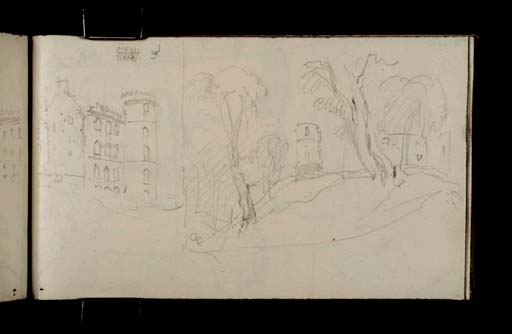Joseph Mallord William Turner Douglas Castle, Lanarkshire 1834
Image 1 of 2
Joseph Mallord William Turner,
Douglas Castle, Lanarkshire
1834
Joseph Mallord William Turner 1775–1851
Folio 21 Verso:
Douglas Castle, Lanarkshire 1834
D26300
Turner Bequest CCLXIX 21a
Turner Bequest CCLXIX 21a
Pencil on off-white wove paper, 113 x 190 mm
Accepted by the nation as part of the Turner Bequest 1856
References
1909
A.J. Finberg, A Complete Inventory of the Drawings of the Turner Bequest, London 1909, vol.II, p.865, CCLXIX 21a, as ‘Ruined castle, &c., on hill. Probably Bothwell castle.’.
1990
Dr David Wallace-Hadrill and Janet Carolan, ‘Turner’s Sketches North of Stirling’, Turner Studies: His Art and Epoch 1775 – 1851, Vol.10 No.1, Summer 1990, p.12.
The two sketches on this page, and further sketches on folios 22 and 22 verso (D26301, D26302), do not depict Bothwell Castle as Finberg tentatively suggested,1 but the ruins of the old Douglas Castle and the eighteenth-century mansion house built to replace it which stand near the Douglas Water in Lanarkshire.2 Turner visited the site during a tour of Lanarkshire on 19 September 1831. As Gerald Finley has suggested, the reason for his visit was to make sketches for potential illustrations to Walter Scott’s Waverley Novels; see Tour of Scotland for Scott’s Prose Works 1834 Tour Introduction.3 Douglas Castle and the surrounding area were the setting for Sir Walter Scott’s last novel, Castle Dangerous, 1831, and although it is not officially a ‘Waverley Novel’, having been published after the identity of the ‘Author of Waverley’ was revealed, it is often included in that group. In the event Turner’s commission to illustrate the novels fell through, so he never worked up these sketches into more finished designs.4
There are two views on the present page. Across the right half of the page, drawn with the sketchbook inverted, is a view of the ruins of the old castle and part of the later castle as seen from the north. All that remained in 1834 of the old castle, built in the late seventeenth century, was the circular corner tower of the encircling wall. This was kept as a folly when the new castle was built and still stands today. To the right, partly hidden here by a tree, is the later Douglas Castle. This was built between 1757 and 1761 by the Adams brothers for Archibald Douglas, 3rd Marquis of Douglas. It was demolished in 1938 having become unsound due to subsidence caused by mining in the area.
The later castle can be seen more clearly in the second sketch at the left of the page. This shows the western side of the building with one of the round corner towers that flank its façade. At the back of the castle there are square towers which can be seen on folio 22 where this sketch continues. Above the sketch Turner has drawn in profile one of the corbels that supports the roof, with a row of corbels to the left.
Thomas Ardill
October 2010
Robert Cadell would have suggested the Douglas Water and Douglas Church as suitable illustrations to Castle Dangerous as he had already published engravings of Douglas Kirk to illustrate the novel in the ‘Magnus Opus’ edition of the Waverley Novels, vol.47, Edinburgh 1833, frontispiece engraving Samuel Sangster after Clarkson Stanfield ‘Castle Dangerous’, also engraved by James Johnstone for Tales and Romances of the Author of Waverley [18mo issue], vol.12, Edinburgh 1833, frontispiece. The Douglas Water was published as an illustration to Tales and Romances of the Author of Waverley ([16mo issue], vo.16, Edinburgh 1833, title-page vignette engraved by James Johnstone after John Wilson Ewbank. After Turner’s association with the Waverley Novels project had ended Cadell commissioned a view of Old Douglas Castle for his ‘Abbotsford edition’ of the novels: Waverley Novels [Abbotsford edition], vol.12, Edinburgh 1847, facing p.343 William Forrest after John Crawford Brown, ‘Remains of the Old Castle of Dougals / Douglas-dale, Lanarkshire’, engraving. Some subsequent editions have also been illustrated with Douglas Castle.
How to cite
Thomas Ardill, ‘Douglas Castle, Lanarkshire 1834 by Joseph Mallord William Turner’, catalogue entry, October 2010, in David Blayney Brown (ed.), J.M.W. Turner: Sketchbooks, Drawings and Watercolours, Tate Research Publication, December 2012, https://www


